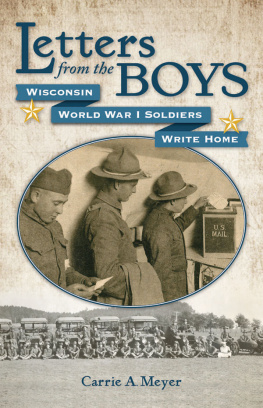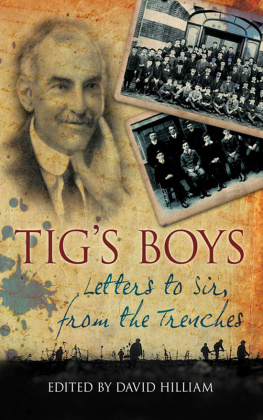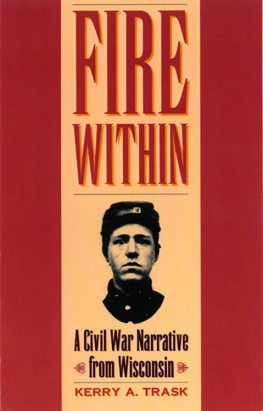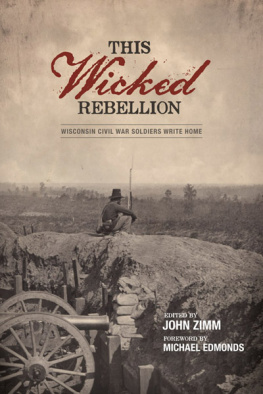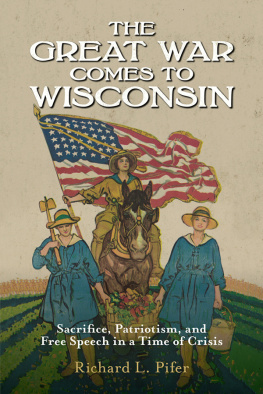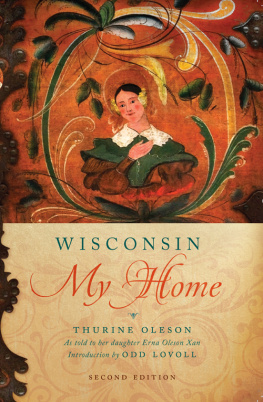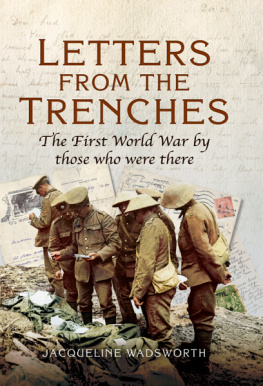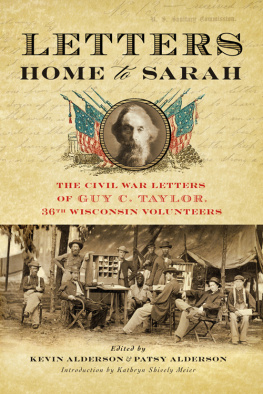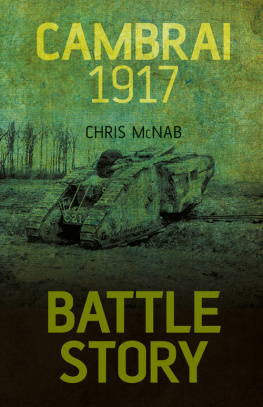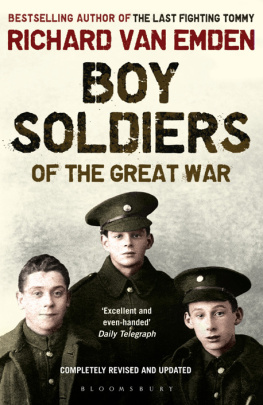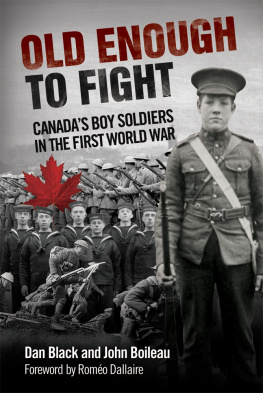Letters from the Boys
Letters from the Boys

Wisconsin World War I Soldiers Write Home
Carrie A. Meyer
WISCONSIN HISTORICAL SOCIETY PRESS
Published by the Wisconsin Historical Society Press
Publishers since 1855
The Wisconsin Historical Society helps people connect to the past by collecting, preserving, and sharing stories. Founded in 1846, the Society is one of the nations finest historical institutions.
Join the Wisconsin Historical Society: wisconsinhistory.org/membership
2018 by the State Historical Society of Wisconsin
E-book edition 2018
For permission to reuse material from Letters from the Boys: Wisconsin World War I Soldiers Write Home (ISBN 978-0-87020-851-5; e-book ISBN 978-0-87020-852-2), please access www.copyright.com or contact the Copyright Clearance Center, Inc. (CCC), 222 Rosewood Drive, Danvers, MA 01923, 978-750-8400. CCC is a not-for-profit organization that provides licenses and registration for a variety of users.
Photographs identified with WHi or WHS are from the Societys collections; address requests to reproduce these photos to the Visual Materials Archivist at the Wisconsin Historical Society, 816 State Street, Madison, WI 53706.
Front cover image: WHi Image ID 88625; back cover image: WHi Image ID 87505
Designed by Shawn Biner
22 21 20 19 18 1 2 3 4 5
Library of Congress Cataloging-in-Publication Data applied for.
Contents
When I began reading the Green County newspapers with the letters this book is based on, I had little idea where the project would take me. I had something more academic in mind, but the words of these young men pulled me in. In the end I needed to tell their story in their own words. Thus my biggest debt is to themto the young men, and some women, now all deceased, who wrote the letters.
For the sake of clarity and to smooth the way for the reader, I have made minor edits of the letters I found, and sometimes I have omitted short passages without calling attention to it with ellipses. In general I was astonished at the quality of the letters and I changed very little. But sometimes newspaper editors and typesetters had clearly introduced spelling errors when the handwritten letters were transcribed and printed a hundred years ago. Sometimes I made slight changes in punctuation or wording to increase clarity. Sometimes there were passages that I omitted either because they added little of relevance or contained material that would only confuse readers of this book. In the end, however, the letters reflect the writing style of the original authorsgrammatical nuances that did not sacrifice clarity were not correctedand remain true to the intent of those who wrote them. Racialist terms, that would be found offensive today, were also retained; it is the readers perogative to judge those who used them.
The Wisconsin Historical Society (WHS) deserves an enormous debt of gratitude for making this project possible and for bringing it to publication. The letters were all published in newspapers that were preserved on microfilm by the society. Even in these digital days, the small-town newspapers on microfilm are a wonderful treasure. The bulk of the photos included here are also from the WHS archives, and many of my sources were housed in the WHS library. Many thanks to the archives and the library staff, and my sincere appreciation to the staff of the Wisconsin Historical Society Press. John Zimm, in particular, has ably guided and shaped the final product with sensitivity and skill, even drafting short passages when I was at a loss for words.
Members and officers of local historical societies in Green County made time to talk to me and help find pictures. Id like to thank Betty Earlywine of the Brodhead Historical Society, Barbara Pierce and Susan McCallum with the Brooklyn Area Historical Society, Roger Dooley with the Monticello Area Historical Society, and Kim Tschudy, a reporter for the Monticello Messenger.
The Provosts Office and the Economics Department at George Mason University deserve thanks for the study leave that allowed me to launch the research for this book in 20112012. Kristen Donahue and Jill Scharl provided research assistance in some of the early stages of the project. Lindsey Hillgartner and Russell P. Horton, archivists at the Wisconsin Veterans Museum, also provided generous assistance. Janet Niewold and her family provided hospitality on several occasions while I was in Madison doing research. Jean Schaible read the manuscript in its early stages and encouraged me to get it published.
Finally, the project would not have been completed without the interest and guidance of my husband, Ernie Carlson. Every step of the way he helped by reading letters, discussing where to go with them, encouraging me to get on with it, reading and rereading chapters of the manuscript, and even helping to select appropriate photographs from the WHS and Wisconsin Veterans Museum collections. His insights and moral support were invaluable and added enormous pleasure to the project.
World War I was a difficult war for Americans to come to grips with, and this was especially true for the people of Wisconsin. Few supported entry into the war, and enormous sacrifices were required.
Woodrow Wilson had won the presidency in 1916 promising to keep America out of war; the vast majority of Americans wanted little part of it. But in Wisconsin, 30 to 40 percent of the population was German by birth or extraction, and this group had even more reason to oppose it. The strong antiwar position of Wisconsins popular Senator Robert M. La Follette was well known. When Congress eventually declared war, La Follette was one of only six senators to vote against it. Moreover, in the House of Representatives, nine out of fifty negative votes were from Wisconsin. Its not so surprising that Wisconsins loyalty was questioned.
Yet when it came time to pitch in, Wisconsin shouldered its share of the burden and more, eagerly proving its patriotism and loyalty. It was the first state to organize a State Council of Defense, the state-level mechanism to muster resources for the war effort. Only 2 percent of the eligible Wisconsin boys failed to register for the draft. In the United States as a whole, the number was more than four times that. Wisconsin readied its National Guard troops early and well. Wisconsin factories worked overtime on war contracts. Wisconsin farmers responded to the demands for more food. Wisconsin women took the place of men in the factories and joined Red Cross circles to make hospital garments and surgical dressings. Wisconsin families observed meatless and wheatless days to conserve food, six weeks before a similar
It is often said the United States arrived late on the scene in World War I and didnt do much fighting. Casualties were light compared to figures for other countries. But that is only because the loss of life and limb was so enormous elsewhere. The United States mobilized 4.4 million troops; approximately 16 percent of the male labor force was inducted into the armed services. Nearly five thousand governmental war agencies were created. At its height, the war absorbed about 23 percent of total economic output in the United States.
In the final tally, Wisconsin lost more lives per thousand population than the country as a whole. When Wisconsins Gold Star list was compiled of the soldiers, sailors, marines, and nurses who died in the federal service during the war, 3,972 names appeared. The rate per thousand population was 1.53 compared to 1.16 for the United States overall.

